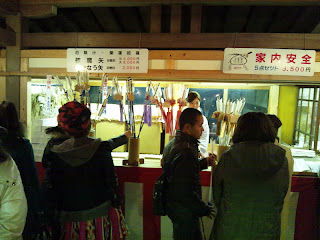Before I get to New Year's here is my donut snowman that my host family bought me for Christmas:
He was delicious and full of a sweet cream too. Along with my snowman I also received a small Kadomatsu, a traditional New Year's decoration that once upon a time was supposed to be a place for visiting family spirits to return during the holidays, and then the decorations were burned on the 7th day releasing the spirits to return. They were traditionally placed on either side of the door outside.
On New Year's eve a friend and I went out to Suwa Shrine to ring in the New Year. There was festival food and no end to Shinto charms you could purchase. Shinto today is much more like a superstition than a religion, people buy charms in the same way American find four-leaf clovers and buy rabbit's feet. In Japan it is just much more specialized and most Japanese, while not really believing in it have an attitude of "It can't hurt". Here are some pictures that were taken around Suwa Shrine that night.
These are Miko (Shrine Maidens) they sell the charms
See that tree on the left? That's where we were later watching the entertainment.
They also have arrows with ribbons that you can buy as charms
It's a big day to buy charms because last year's have worn out
After looking around a little we found a spot up high and after counting down to the new year we watched the dragon dance. I was happy to see this in person because it had not been performed at Kunchi this last year like it normally is.
Alternatively I found a video made by people running the festival, if you watch in HD and are looking up in that corner by the tree you can actually see me and my friend Aaron.After the dragon dance we grabbed some food and headed home. One thing that they also do is to ring the giant bell at the temple 108 times on New Year's Eve to remove the 108 flaws (evil passions) of humanity so we don't carry them into the New Year. This is a Buddhist tradition so this was carried out at Buddhist Temples, not Suwa Shrine (which is Shinto). There is also a big singing content on TV that night that has become traditional entertainment.
The next several days I was treated to a spiced sake at breakfast, it apparently is normal for children to also have some on the first 3 days of the New Year. I also had a variety of traditional foods, mostly fish cakes and flavored vegetables, there was also mochi soup everyday. If you're not familiar with mochi it is a rice cake, it's very chewy and gooey, almost with the consistency of thick melted cheese, but stickier. Apparently there are fatalities every year amongst elderly people that literally bite off more than they can chew and end up chocking to death. It is also customary to go to the shrine on the 1st to offer a New Year's prayer to the gods, my host family didn't think it would be worth me going to watch though (and I have seen people going to the Shrine before to pray so it was nothing new). I also got to see the Nengajou (New Year's Greeting Cards) that my family received, these are fairly normal to send rather than Christmas cards. It is also customary to clean the house during the New Year so I vacuumed my room.
My next visit to the shrine was on the 7th around 8am when Suwa Shrine serves a free rice gruel with a pickled plum in it. It was good, and one of the first times I really enjoyed a pickled plum (they are allegedly sour, but to me they just taste incredibly salty). I was interviewed by two different news crews, which is always amusing, I don't think any of them really understand the phrase "I speak a little Japanese." I think I need to start telling them if they speak to me like I am 3 years old that I will probably understand them. The lady in front of me in line asked about where I was from and what I was doing in Nagasaki, commenting several times that I was very tall, a fact that seemed to really impress her.
Note the giant Kadomatsu on either side of the steps
This is where they are preparing the rice gruel
These are prayers/wishes that people have written down
In the two pictures above you can see the Shinto Priest in orange along with the head Miko. The lady shown in front of me is not the one I was talking to, she is actually below the picture because I am standing over her.
These are all the poor people waiting behind me, should have gotten there earlier, I was 7th in line.
Shimekazari, but it's made of rope. Like most thing Shinto it exists to promote good fortune (safety and prosperity), this was outside of the Post Office shortly after the New Year.
I hope you enjoyed this brief look at the New Year in Japan, if you're interested to learn more you can check out Wikipedia here: http://en.wikipedia.org/wiki/Japanese_New_Year There are a lot of things I learned about in school that I did not get to see this year, but it was interesting to experience the New Year in a different culture and have it be more important than what I'm use to in America.






















No comments:
Post a Comment